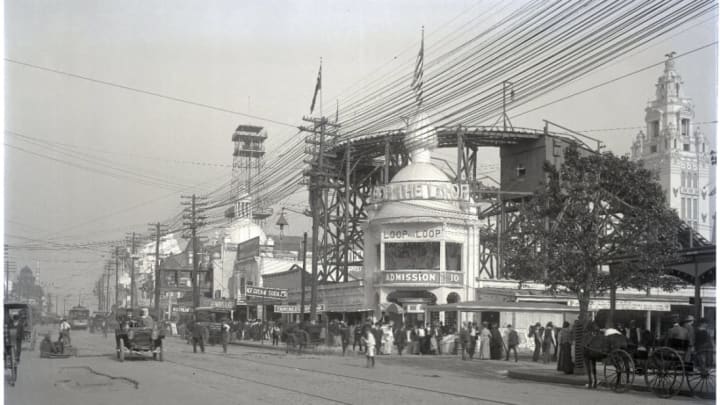The rides at Coney Island aren't the tallest or fastest in the world, but they have a way of reminding riders of their mortality. The Cyclone shows its age as it vibrates over its wooden track, the Wonder Wheel creaks loud enough to be heard from the line below, and regulations throughout the park seem looser than they do in Disneyland. But none of the rides at Coney Island today are as perilous as Rough Riders, the Spanish-American War-themed roller coaster that killed seven people in the early 1900s.
At the turn of the 19th century, Coney Island was the largest amusement area in the United States. Tourists flocked to the Brooklyn shore to travel along the boardwalk, see the sideshows, and experience the groundbreaking thrill rides. Coney Island was home to several roller coasters at this time, many of which offered more thrills than riders could handle. The Flip Flap Railway, the world’s first looping coaster, was infamous for knocking people out, and many paid to be spectators instead of riders. Other early Coney Island coasters featured cars shaped like horses that guests had to straddle and cars that cleared (or didn’t clear) gaps in the track.
Coney Island debuted its Rough Riders coaster in 1907. Less than a decade earlier, Theodore Roosevelt had resigned from his post as the Assistant Secretary of the Navy and led the First U.S. Volunteer Cavalry—nicknamed the Rough Riders—into the Spanish-American War. Roosevelt was president in 1907, and the Rough Riders still loomed large enough in American culture to get their own roller coaster. The ride’s operators dressed in military uniforms, and cars passed by scenes depicting the war before ascending the hill. Beyond the creative theme, the ride also offered guests an exciting format. Unlike most other Coney Island coasters, which were propelled by gravity, this one ran on an electric third rail—much like a subway car. “Conductors” were assigned to each train, and they had control over how fast the cars moved over inclines and around curves.
As it turned out, technology invented to safely transport the public wasn’t the best fit for an amusement park. Because the cars had to be operated manually by park employees, there was no way to regulate how fast they went. Many operators pushed the ride vehicles to their limits; instead of slowing down on drops and sharp turns, they often went ahead at full speed.
In 1910, Rough Riders’s lack of safeguards proved disastrous. During one ride, the coaster turned too quickly, and 16 riders were flung from their seats. Four of them perished in the accident. Surprisingly, this tragedy wasn’t enough to get the attraction shut down, and on July 27, 1915, history repeated itself. That day, six passengers boarded the ride, and when the driver sped down an incline and into a curve, the car tipped onto its side. The operator and four riders flew out of the vehicle, crashing into the cheap iron railing enclosing the track. The fence broke and three of the victims fell 30 feet to their deaths onto the concrete below. The conductor’s body hit an onlooker on the way down and sent her to the hospital.
Two of the riders that were tossed from the coaster survived: Clara Moles and her 4-year-old son Edward. When the car flipped, Clara gripped the handrail with one hand and used her other arm to hold her son. She stayed dangling above the pavement until two detectives who had witnessed the event climbed up the coaster’s framework and pulled the pair onto the track.
Thomas Ward, the ride’s manager, was arrested following the incident and charged with homicide. A jury ultimately exonerated him after deciding that the accident was “unavoidable,” but the roller coaster itself didn’t get off as easy. It ceased operations for good in 1916, apparently proving too dangerous even for Coney Island’s risk-seekers.
